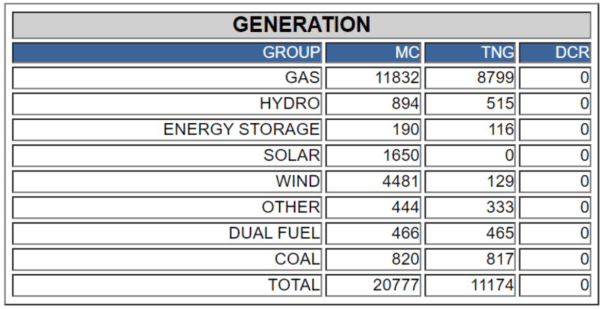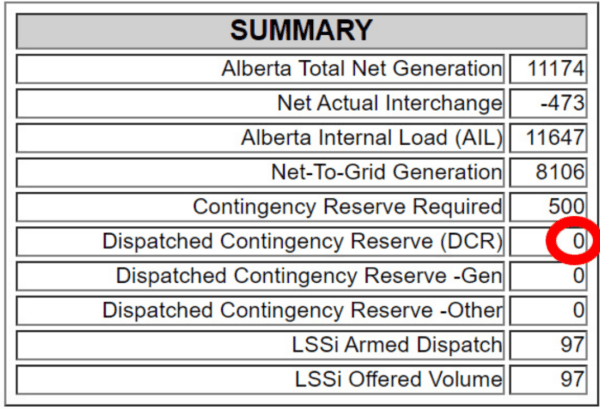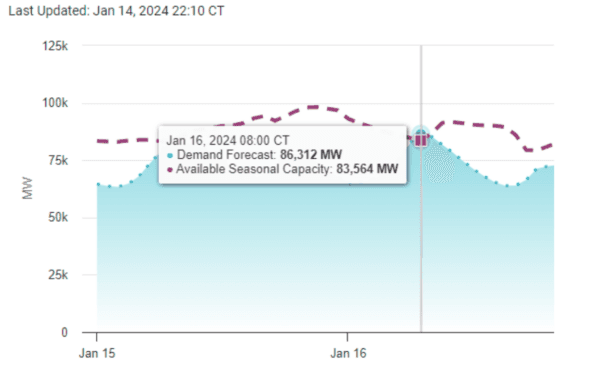Third Alberta Electrical Grid Alert Issued in Three Days
The Alberta Electric System Operator (AESO) declared its third grid alert in three days on Jan. 14 as frigid temperatures continued to blanket the province, driving up electricity demand while reducing available renewable power supply.
According to X bot account @ReliableAB, which posts hourly updates of AESO data on the Alberta grid, at 3:39 p.m., solar was falling, with 332 megawatts being produced from the 1,650 megawatts of grid-scale solar.
Earlier in the day, Alberta Premier Danielle Smith had warned of the possibility of another grid alert. At 11:28 a.m., she posted on X thanking Albertans to reduce electricity use, and asking them to continue doing so.
“Unfortunately, due to today’s continued extreme weather, we’re not out of the woods yet. To avoid another risk to our electricity grid, please continue to be diligent and avoid unnecessary electricity use,” she said.
Earlier in the afternoon, Alberta was exporting power to both British Columbia and Montana. But by 4:08 p.m., it was importing 267 megawatts, including 89 from Saskatchewan.
Contingency Reserve Falls
By 4:37 p.m., AESO data showed the dispatched contingency reserve (DCR) had fallen substantially. All available 548 megawatts hydro was thrown into the grid, with none in reserve. All that was left in the the AESO’s reserve back pocket was 12 megawatts of natural gas and 115 megawatts of batteries, with 15 megawatts of batteries already in play producing power to the grid. But at full output, Alberta’s nine 20 megawatt batteries typically only produce that much power for an hour. And the last 20 megawatts of solar was about to disappear off the board, with only 103 megawatts of wind on the grid, out of the 4,481 megawatts of grid-scale wind installed.
Out of 87 natural gas-fired generating units (including one coal/gas dual fuel), only one unit has any additional capacity.
By 4:58, 262 megawatts of hydro were back on the contingency reserve board, with total DCR standing at 389 megawatts.
Contingency Hits Zero
At 5:08 p.m., Alberta’s contingency reserve fell to zero across the board, despite a required contingency of 500 megawatts. There was no additional hydro, gas or coal available. The six available batteries were all put into action, providing 79 megawatts between them for about 10 minutes.


Around this time, imports jumped to 608 megawatts, with 434 coming from British Columbia, 21 from Montana, and 153 (the maximum possible) from Saskatchewan. Hydro now had 60 megawatts on the DCR list, but still no additional natural gas was available.
British Columbia to the Rescue
As the 6 o’clock hour progressed, British Columbia substantially increased its power exports to Alberta. By 6:45, that number was 496 megawatts, while Montana was contributing 14 and Saskatchewan 153. The total 664 made a big impact on Alberta’s ability to put 253 megawatts of hydro onto its contingency board. By this point, there was now 92 megawatts of gas available, and the contingency reserve hovered around 432 megawatts – a much more comfortable margin than it had been an hour and a half before.
That was important, too, because by this point, only four of Alberta’s t0 grid-scale batteries had any juice left. While they had done their job several times in the past three days, filling in for short times when needed most, the fact that six of those batteries were no longer showing on the DCR list also revealed their limitations.
Wind had also built up to 215 megawatts. Despite -34 C conditions, the Halkirk Wind Power Facility, east of Stettler, was producing 60 megawatts, having slowly built up power generation since 11:30 a.m. While a handful of the wind farms were
The AESO pool price for power remained at the set maximum of $999.99 per megawatt-hour from 5 to 9 p.m.
However, later in the evening, power imports into Alberta fell tremendously, and the grid alert still had not been called off. By 9:19, British Columbia imports fell to next to nothing before starting to pick up again. Saskatchewan’s contribution fell to 92 megawatts. And by this point the generation contingency reserve was hovering once again just over 200 megawatts. At 9:22 there was zero natural gas DCR available, 148 megawatts of hydro, and 115 megawatts of batteries available.
At 10:12 p.m., the AESO declared the end of the grid alert. It had lasted for 6.5 hours. At this point, 15 wind farms were providing at least some power, totaling around 255 megawatts.
American Grid Under Stress, Too

On the same day, a milder form of grid alert was issued by the Southwest Power Pool (SPP). The SPP runs from the Canada/US border south of Estevan, Sask. to the Texas Panhandle and incorporates all or part of 14 states in the Great Plains.
At 11:50 a.m. central time, the SPP said, “SPP is issuing a Conservative Operations Advisory for its entire Balancing Authority effective 4 a.m. CT Sunday, Jan. 14 with an anticipated end of 9 p.m. CT Tuesday, Jan. 16.
“Conservative Operations Advisories do not require the public to conserve energy, but are issued to raise awareness of potential threats to reliability among entities responsible for operating transmission and generation facilities. Individuals should contact their local utility for details specific to their area.”
At 6 p.m. central time, the SPP was getting 42 per cent of its power from natural gas, 33 per cent from coal, and 15 per cent from wind. On a more typical day, wind can account for half or more of the power generated in the SPP.
At the far end of the SPP, Texas’s grid operator, ERCOT, issued a “conservation appeal” for the morning of Monday, Jan. 15 from 6 – 10 a.m. CT, stating,
Source link






